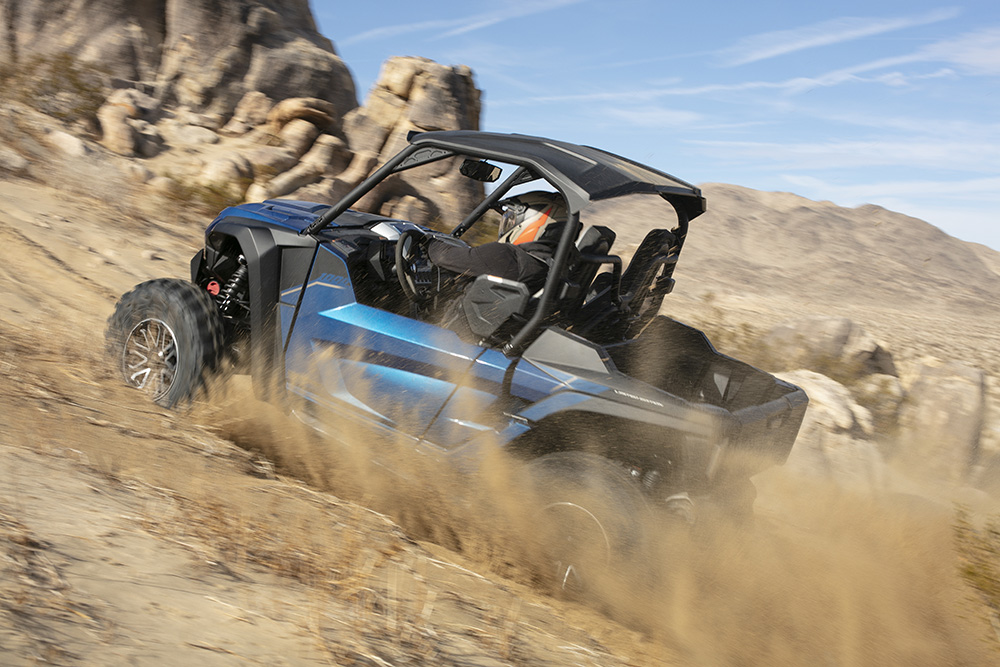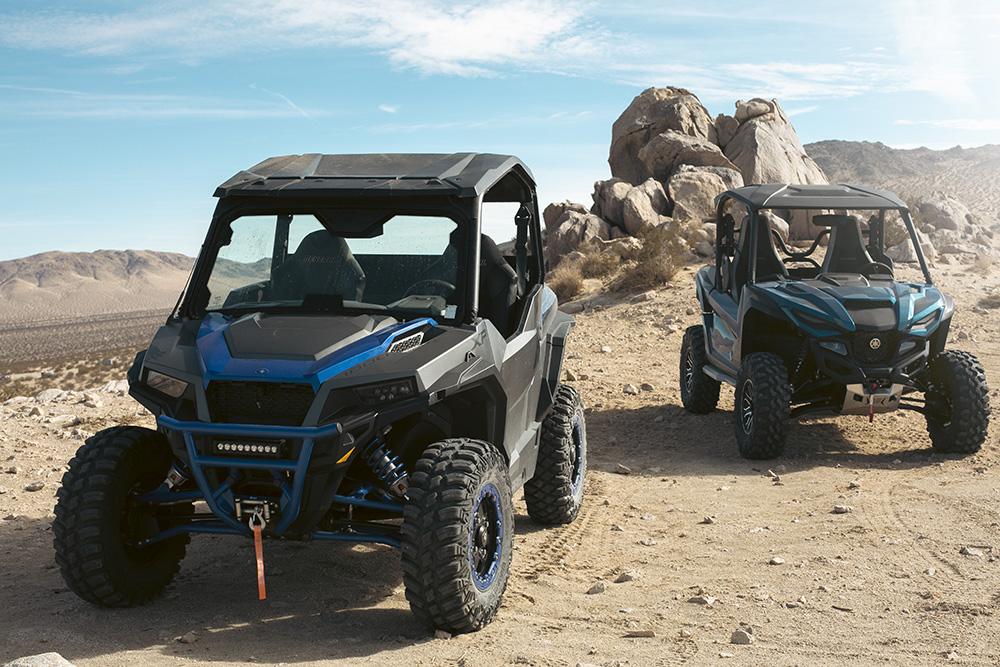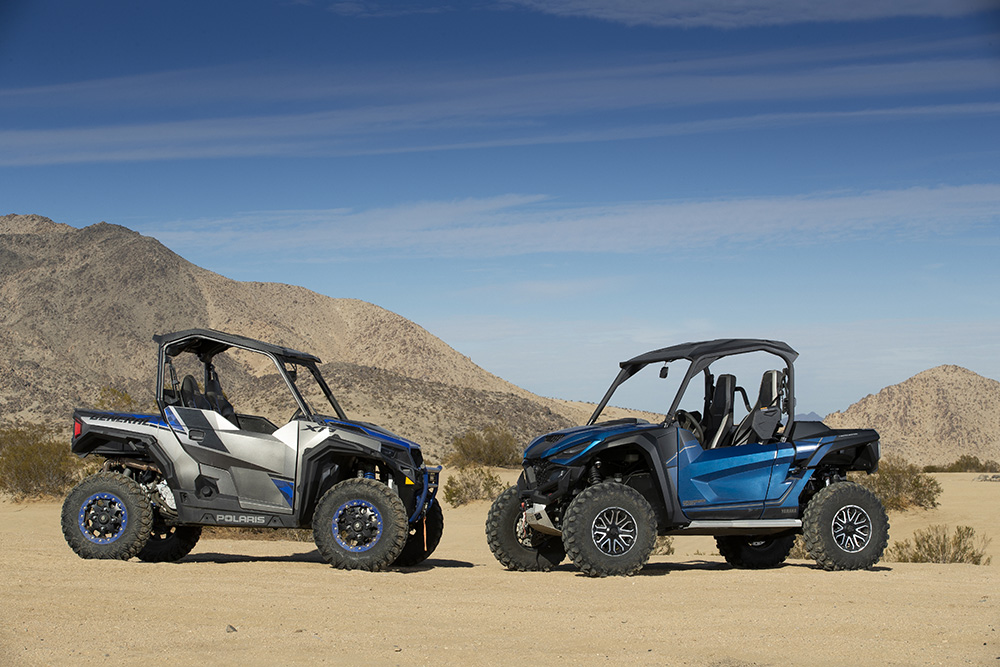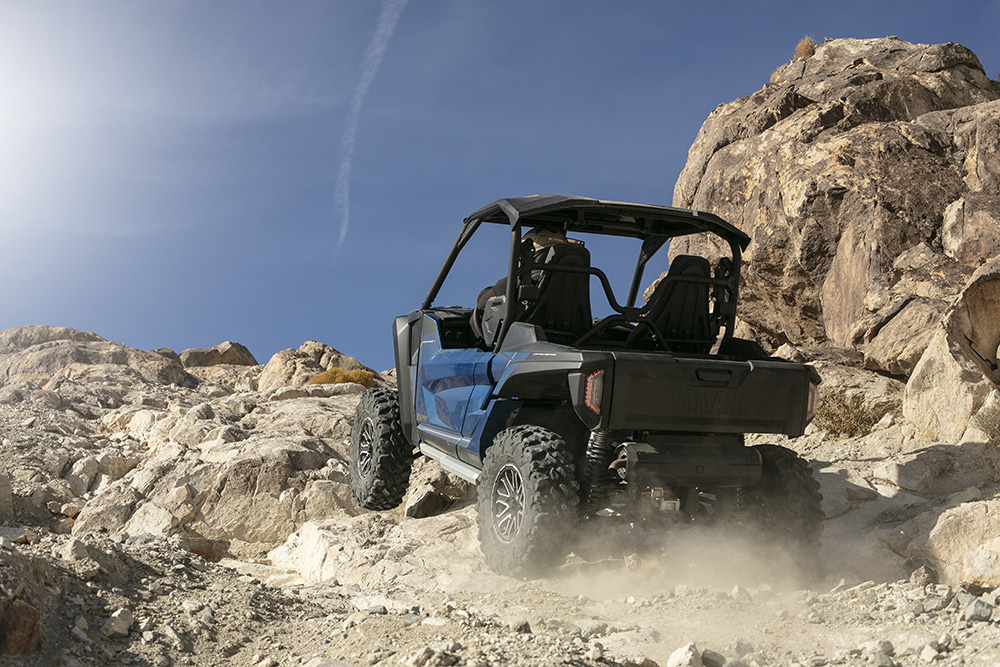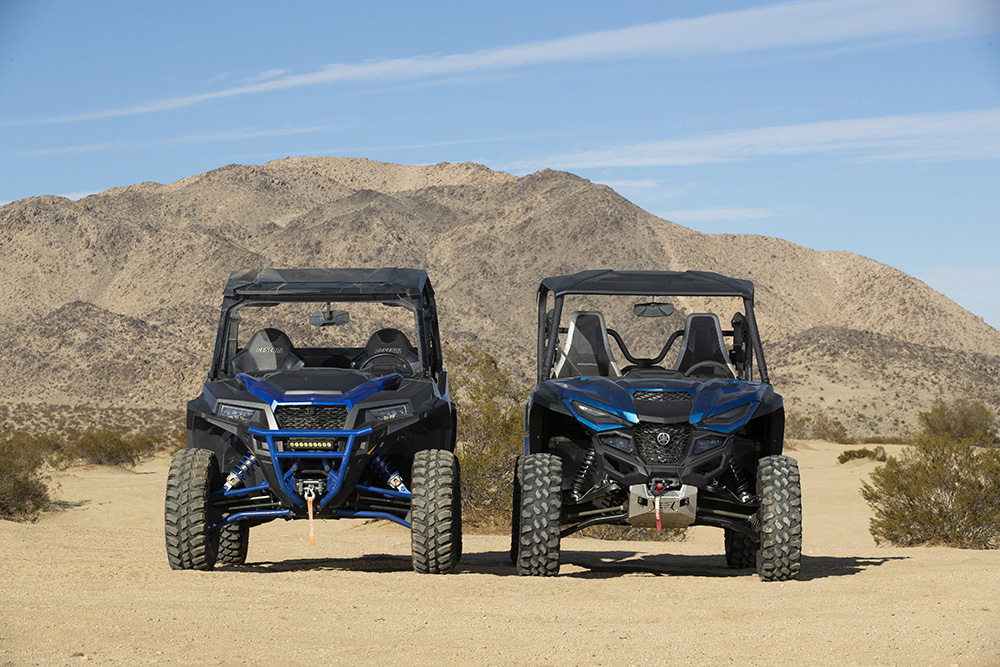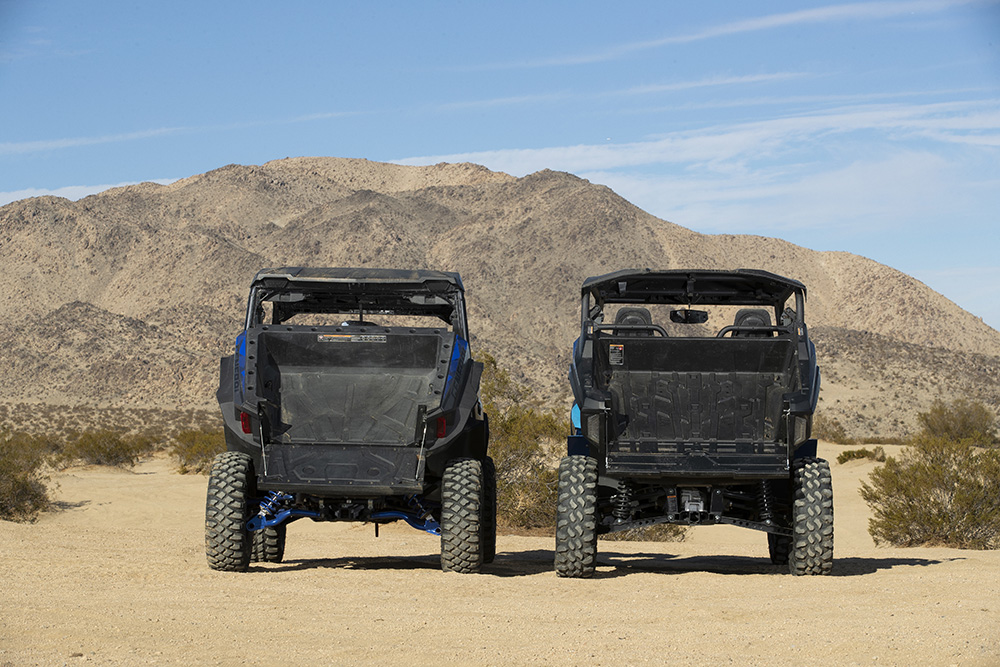The search for the perfect all-round UTV seems to get easier every year. Easier may not be the right term to describe it; we just get more good choices. The two pictured here are currently the best in the market for good-‘ol-fashioned UTV recreation, a class that both Polaris and Yamaha recognize as extremely important. After all, recreating is where most of us spend our UTV hours. While the long-travel turbo cars usually steal the headlines, the Generals and RMaxs are flowing out of dealerships faster than production can handle. So, which UTV is the Ultimate Adventure Rig?
Yamaha RMAX2 vs Polaris GENERAL XP
Which UTV is the Ultimate Adventure Rig?
Words: Staff of UTV Off-Road // Photos: Bradley Howe / Adam Campbell Photography
Highlights:
- Incredibly comfortable ride in really rough terrain
- D-Mode throttle controller is a gem
- 4WD system is the best in the business
- Incredible amounts of grip
POLARIS GENERAL XP 1000 FACTORY CUSTOM EDITION
Highlights:
- Sporty engine tune and quick throttle response
- Comfortable cab and tons of storage
- Ride Command
- Rockford Stereo
As 2021 drew to a close, we found ourselves really racking up the miles on these two units. We have logged a couple thousand miles on each platform this year collectively at UTV Off-Road, between camping trips, Rubicon excursions, blasting through the Minnesota woods and climbing to dizzying heights in the La Salle Mountains. Before we get into the nitty gritty, be cognizant of the fact that either vehicle represented here is a fantastic way to get out and enjoy the outdoors, and there is no wrong choice. Life is short, so make sure you spend time exploring!
Engine:
On display here we have two very similar powerplants, albeit with completely different recipes. Both the General and RMAX utilize a parallel-twin, dual overhead-cam engine configuration mated to a CVT transmission. Both produce right around 110 horsepower, with the Polaris edging the Yamaha out by a couple of ponies. Despite their similarities, however, the way they dole out power is very different.
The General XP runs much like a RZR XP 1000. The clutches are lightweight and are tuned to deliver power quickly, and it comes on in a hurry. The General loves to fry the tires and slide around corners, encouraging its driver to participate in gymkhana as much as possible.
The RMAX is decidedly more businesslike in its approach, preferring to smoothly dump in the torque and let the tires claw it forward in a hurry. The RMAX puts its power down better than the General, thanks in part to the Maxxis Carnivore rubber. When they both hook up, it is a very close race, usually decided by whoever got the better start. The Yamaha’s powertrain feels a little heavier in terms of rotational mass, no doubt due to the beefier clutches and internal wet clutch. However, the tradeoff is a 10 year belt warranty on the RMAX.
Both powertrains will rocket their vehicles to top speeds just north of 70 mph, which is plenty for a vehicle this size. Both also produce aggressive, throaty exhaust notes. The Polaris is quieter in the cab.
Transmission/Drivetrain:
This is where the RMAX and the General start to part ways. The Yamaha has the superior toolset for low-traction situations, offering full-time 4WD and a locking front differential. The General has an on-demand 4WD system, activated by wheel speed sensors telling the computer that the rear tires are spinning. This works great for most situations, but when things get really ugly, the General starts to slip a little.
Crawling downhill in the General can be a tricky situation, as we have encountered situations where the General’s engine braking will activate and drag only the rear tires, leaving the fronts freewheeling and causing the car to essentially e-brake slide down the hill. The RMAX is more predictable and capable in extreme situations, so keep that in mind if your type of riding ever requires things like winching. The RMAX also exhibits better manners in low-speed maneuvering, thanks in part to its slightly slower clutch takeup compared to the General’s sportier tune.
Suspension:
Both cars technically use dual A-arm suspension front and rear, but the designs are very different. The General features 14 inches of wheel travel front and rear controlled by wonderfully-tuned Walker Evans Velocity Series shocks, which do a fantastic job of keeping the General’s ride smooth while hammering over bumpy trails. The arched A-arms are designed to provide ample ground clearance, which they do. They also look great – especially in the metallic blue hue of the Factory Custom Edition.
Yamaha’s RMAX utilizes dual A-arms front and rear as well, but offers up slightly different travel numbers. Yamaha claims 14.2 inches of front travel and a whopping 16.9 inches at the rear, controlled by either Fox QS3 (R-Spec, XT-R, LE) or Fox Podium 2.0 (Sport) shocks. While Yamaha’s RMAX Sport would technically be a better comparison for the General, we were not able to get one on-hand for testing.
Head to head, the RMAX edges the General out in the suspension department. The General has a slightly better ride in high-frequency chop, but the RMAX’s deeper suspension, especially out back, allow it to cruise past the General on rougher trails at a higher rate of speed. Big whoops will cause the RMAX to buck a little, but both machines are surprisingly capable in rough terrain.
Tires/Wheels/Brakes:
Polaris outfitted the General with Pro Armor Crawler tires, and even gave it specific front and rear tread patterns for increased handling performance. The tires wear well and have held up decently in our testing, but they do lack the outright grip and longevity that the Maxxis Carnivores on the RMAX exhibit. On flat, winding fire roads, the RMAX hangs onto the road surface better than the General XP, showing far less understeer and allowing more throttle input.
Both machines have stellar brakes. With dual-piston calipers and relatively large rotors at all four corners of each machine, stopping power is not a worry, even if you go with larger tires. Both feature a factory beadlock wheel in certain trims for 2022, although the RMAX LE does not come with them. The General and RMAX both have square tire setups, meaning the fronts and rears are the same size. This makes carrying or finding a spare much easier.
The RMAX has 14 inch wheels, whereas the General has 15s. The ride quality difference between the two is not noticeable, as both machines roll over rocky, rutted terrain smoothly and filter out all but the biggest of hits the tires are taking.
Impressions:
In all of our testing, neither machine left us stranded. The Yamaha’s cabin and touch points are all a level above the Polaris in terms of fit and finish, even down to the feel of the steering. The General Factory Custom Edition is also $2,200 more expensive than the RMAX LE, which is a good deal of coin. Tasks like operating the dump bed, opening and closing the doors, adjusting the passenger grab bar and operating the controls are all more fluid in the Yamaha.
On the trail, the General typically exhibits a smoother ride than the RMAX until they are pushed. Once the going gets really rough and the drivers demand more from the machines, the RMAX starts to pull ahead, as its performance envelope is slightly higher than the General’s. Low-speed maneuvering is much more comfortable and precise in the RMAX, thanks in part to clever tuning and its D-mode throttle controller.
As an owner, you will likely be happy with either machine. Maintenance is a little more straightforward on the General, with a simpler oil change procedure. We do think the Yamaha will hold up better over time, as it seems to be built a little tougher than the Polaris, at least from where we sit in the driver’s seat. If exploration is your thing, either of these two cars are fantastic. When the trails get extremely rough, the RMAX is a better choice, and a more capable one as well. It offers better fit and finish, more suspension capability and better crawling manners, all for less money. This class is starting to really heat up, and we can’t wait to see what’s in store for the future of these two great machines.
|
MACHINES: |
2021 YAMAHA WOLVERINE RMAX 1000 LE |
2021 POLARIS GENERAL XP 1000 FCE |
|
ENGINE PERFORMANCE: |
4 |
4 |
|
TRANSMISSION: |
5 |
3 |
|
ENGINE BRAKING: |
5 |
3 |
|
SUSPENSION: |
4 |
4 |
|
HANDLING: |
5 |
4 |
|
RIDE COMFORT: |
4 |
5 |
|
BRAKING: |
5 |
5 |
|
WHEELS & TIRES: |
4 |
4 |
|
ERGONOMICS: |
5 |
4 |
|
MAINTENANCE: |
4 |
4 |
|
INSTRUMENTATION: |
5 |
5 |
|
FIT & FINISH: |
5 |
3 |
|
OVERALL QUALITY: |
5 |
4 |
|
CABIN NOISE: |
4 |
5 |
|
CARGO: |
5 |
5 |
|
PRICE: |
5 |
3 |
|
TOTAL OUT OF 80: |
74 |
65 |
Specifications:
YAMAHA WOLVERINE RMAX 1000 LE
ENGINE & DRIVETRAIN
Type: 999cc: 108 (EST) hp, 4-Stroke, DOHC, 4 valve per cylinder parallel twin
Cooling: Liquid
Fuel Delivery System: Yamaha Fuel Injection (YFI) with dual 48mm throttle bodies
Drive System Type: Ultramatic V-belt with all-wheel engine braking; L/H/N/R
Drivetrain: On-Command 3-way locking differential; 2WD, 4WD, full diff-lock 4WD
Power Steering: Electronic Power Steering (EPS)
SUSPENSION
Front Suspension: Independent Double Wishbone with sway bar, 14.2” Travel
Front Shocks: Fox Podium 2.0 QS3
Rear Suspension: Independent Double Wishbone, 16.9” Travel
Rear Shocks: Fox Podium 2.0 QS3
BRAKES
Front Brakes: Dual Hydraulic Disc
Rear Brakes: Dual Hydraulic Disc
TIRES / WHEELS
Front Tires: 30 x 10R-14; Maxxis Carnivore
Rear Tires: 30 x 10R-14; Maxxis Carnivore
Wheels: Cast Aluminum
DIMENSIONS
Overall Vehicle Size (L x W x H): 119.3 x 66.1 x 77.8 in
Wheelbase: 86.7 in
Ground Clearance: 13.8 in
WET Weight: 1,876.1 lb
Cargo Box Capacity: 600 lb Rear Dumping Box
Towing Capacity: 2,000 lb
Fuel Capacity: 9.2 gal
WARRANTY:
Factory: 6-month Limited Factory Warranty, Yamaha 10-year Belt Warranty, optional extended plans may be available through your dealer
POLARIS GENERAL XP 1000 FACTORY CUSTOM EDITION
ENGINE & DRIVETRAIN
Type: 999cc: ProStar 110 hp, 4-Stroke, DOHC, 4 valve per cylinder parallel twin
Cooling: Liquid
Fuel Delivery System: Electronic Fuel Injection
Drive System Type: Automatic PVT P/R/N/L/H
Drivetrain: On-Demand True AWD/2WD/VersaTrac Turf ModePower Steering: Electronic Power Steering (EPS)
SUSPENSION
Front Suspension: Long Travel, High Clearance Dual A-Arm with Stabilizer Bar, 14″ (35.6 cm) Travel
Front Shocks: Walker Evans Velocity Series Shocks
Rear Suspension: Long Travel, High Clearance Dual Arm IRS with Stabilizer Bar, 14″ (35.6) Travel
Rear Shocks: Walker Evans Velocity Series Shocks
BRAKES
Front Brakes: Hydraulic Disc with Dual-Bore Calipers
Rear Brakes: Hydraulic Disc with Dual-Bore Calipers
TIRES / WHEELS
Front Tires: 30 x 10-15; Pro Armor Crawler XF
Rear Tires: 30 x 10-15; Pro Armor Crawler XG
Wheels: Cast Aluminum with Beadlocks
DIMENSIONS
Overall Vehicle Size (L x W x H): 118.2 x 64.0 x 75.0 in
Wheelbase: 83.0 in
Ground Clearance: 13.5 in
DRY Weight: 1,712.0 lb
Cargo Box Capacity: 600 lb Rear Dumping Box
Towing Capacity: 1,500 lb
Fuel Capacity: 9.5 gal
WARRANTY:
Factory: 6-month Limited Factory Warranty, optional extended plans may be available through your dealer



